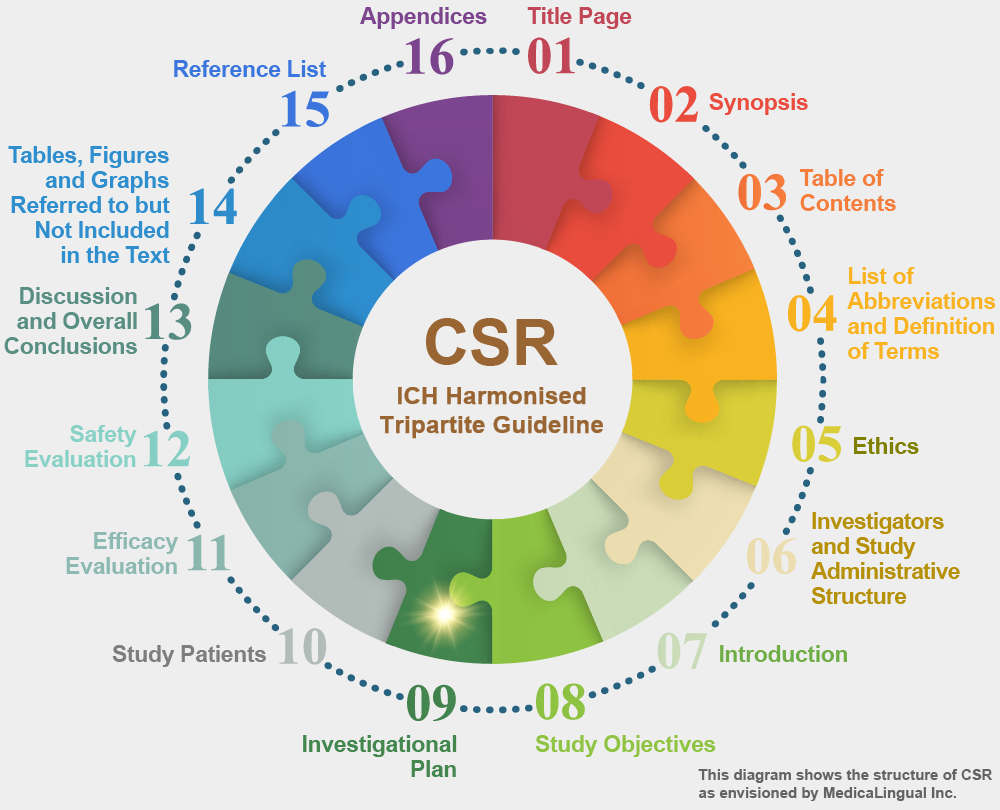
治験の統括報告書の構成と内容に関するガイドライン
平成8年5月1日 薬審第335号
各都道府県衛生主管部(局)長あて 厚生省薬務局審査課長通知
STRUCTURE AND CONTENT OF CLINICAL STUDY REPORTS
Recommended for Adoption at Step 4 of the ICH Process on 30 November 1995 by the ICH Steering Committee
9. 治験の計画
9.7 治験実施計画書で計画された統計手法及び被験者数の決定
9.7.1 統計及び解析計画
治験実施計画書で計画された統計解析及び結果を得る前になされた全ての変更について記述すること。ここで強調すべきことは,どのような解析,比較及び検定が計画されていたかであり,実際にどのような手法を用いたかではない。もし主要な項目が複数回測定されたならば,被験薬と対照との比較に用いるために計画された特定の測定値(例えば,試験全体を通じての数回の測定値の平均,特定の時点の値,治験完了例のみの値,治療中の最終の値)を明らかにすること。同様に,基準値からの変化,傾きの解析,生命表解析といった複数の解析手法が妥当とみなせる場合には,計画された手法を明確にすること。また,主たる解析中に共変量による調整を含めるかどうかについても明らかにすること。
9. INVESTIGATIONAL PLAN
9.7 STATISTICAL METHODS PLANNED IN THE PROTOCOL AND DETERMINATION OF SAMPLE SIZE
9.7.1 STATISTICAL AND ANALYTICAL PLANS
The statistical analyses planned in the protocol and any changes made before outcome results were available should be described. In this section emphasis should be on which analyses, comparisons and statistical tests were planned, not on which ones were actually used. If critical measurements were made more than once, the particular measurements (e.g., average of several measurements over the entire study, values at particular times, values only from study completers, or last on-therapy value) planned as the basis for comparison of test drug/investigational product and control should be specified. Similarly, if more than one analytical approach is plausible, e.g., changes from baseline response, slope analysis, life table analysis, the planned approach should be identified. Also, whether the primary analysis is to include adjustment for covariates should be specified.
利用できるデータのある患者であっても解析から除外する旨の計画された理由がある場合には,その理由を記述すること。別個に結果を吟味するような部分集団があれば,それらを明確にすること。分類尺度による反応(概括尺度,重症度得点,特定の大きさの反応)を解析に用いる予定であったならば,それらを明確に定義すること。
If there were any planned reasons for excluding from analysis patients for whom data are available, these should be described. If there were any subgroups whose results were to be examined separately, these should be identified. If categorical responses (global scales, severity scores, responses of a certain size) were to be used in analysing responses, they should be clearly defined.
治験の結果に関するモニタリングが計画されていれば記述すること。データモニタリング委員会が開催された場合には,治験依頼者の管理下であるか否かを問わず,その構成及び実施手順を記述し,試験の盲検性を維持するための手順を示すこと。計画された中間解析の頻度及び性格,治験の終了に結びつく特定の条件並びに中間解析のためになされた統計的な調整について全て記述すること。
Planned monitoring of the results of the study should be described. If there was a data monitoring committee, either within or outside the sponsor’s control, its composition and operating procedures should be described and procedures to maintain study blinding should be given. The frequency and nature of any planned interim analysis, any specified circumstances in which the study would be terminated, and any statistical adjustments to be employed because of interim analyses should be described.
9.7.2 被験者数の決定
計画された症例数及びその設定根拠,例えば統計的な考察又は実施上の制約を提示すること。症例数の算出方法をその算出式又は出典とともに示すこと。算出に用いられた推定値を示し,その推定値がどのようにして得られたかを説明すること。治療間の差を見いだすことを意図する治験においては,その試験デザインによって検出したい差を明らかにすること。新治療が少なくとも標準治療と同等の有効性を有することを検証しようとする実薬対照試験においては,症例数の決定にあたって,これ以上大きいと許容できないと考えられる治療間の差,すなわちその試験デザインによって棄却しようとしている差を明らかにすること。
9.7.2 DETERMINATION OF SAMPLE SIZE
The planned sample size and the basis for it, such as statistical considerations or practical limitations, should be provided. Methods for sample size calculation should be given together with their derivations or source of reference. Estimates used in the calculations should be given and explanations provided as to how they were obtained. For a study intended to show a difference between treatments, the difference the study is designed to detect should be specified. For a positive control study intended to show that a new therapy is at least as effective as the standard therapy, the sample size determination should specify the difference between treatments that would be considered unacceptably large and therefore the difference the study is designed to be able to exclude.










